I DISCUSSION: "WHY DO WE NEED TO LEARN FOREIGN LANGUAGES, E.G. ENGLISH?
Description:
We discussed in the group if and why is it necessary to study foreign languages. The children watched a video in English and realised that if one doesn’t understand other languages, one cannot understand other people and talk to them.

Time of activity: October 9th, 2017
Group: Allikalapsed
Age: 6-7 years
Teacher: Eliko Tippi
Objectives:
The child understands the need to study foreign languages.
The child knows how to greet and say good-bye in English.
The child knows how to introduce themselves and ask for the companion’s name.
Materials:
The computer, internet (Good morning+More Kids Dialogues | Learn English for Kids | Collection of Easy Dialogue. Lesson 1 - Hello. What's your name?)
Order of activity:
The children watched a video in English. Discussion of the video in Estonian - what was it about? What words did they understand? Were there any familiar words (hello, thank you)? The teacher explained the English expressions heard on the video. Rewatching the video and retelling it again, this time the children were able to do it more precisely.
Sources: https://www.youtube.com/watch?v=7k4uBAiJsMM
---------------------------------------------------------------------------
II SHOPPING GAME “THE POLITE SHOPKEEPER” WITH THE BLUE-BOT FLOOR-ROBOT
Description: The children sort the food products based on the principles of healthy lifestyle and nutrients ( with the help of magazine cut-outs). The teacher introduces the English names for the products (cheese, milk etc.). The child uses Blue-Bot to “go to the store” to buy the specific product, using common expressions in English like ‘hello’, ‘good-bye’, ‘thank you’ etc. They use the same expressions while playing creative shop games.
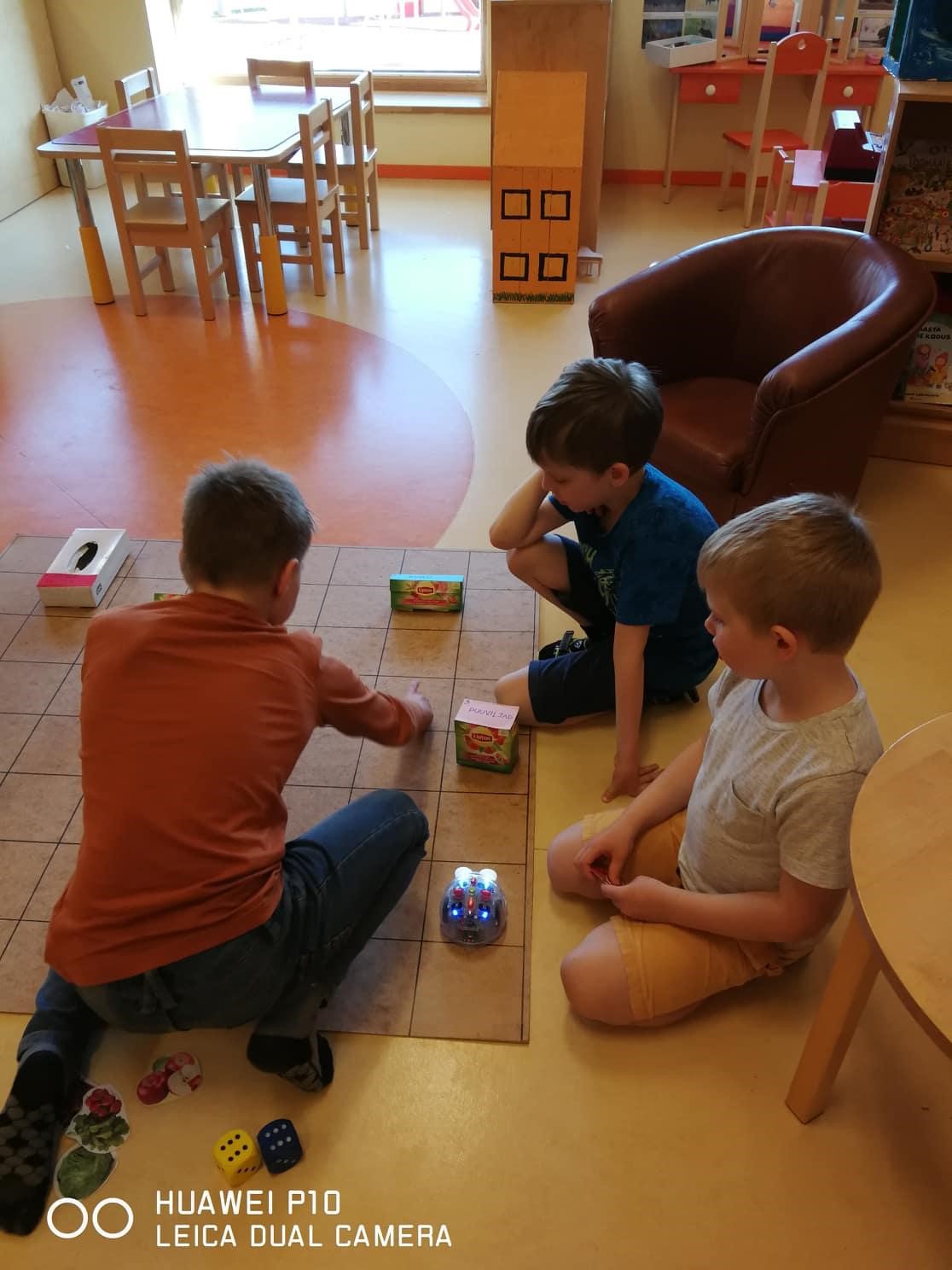

Time: April 19th, 2018
Group: Allikalapsed
Age: 6-7 years
Teachers: Eliko Tippi, Kristi Hansen
Objectives:
General knowledge:
The child applies their experiences, knowledge and understanding of the surrounding world creatively in the play.
The child uses different roles and materials in the playing environment.
Environment:
The child differentiates between healthy and unhealthy in everyday life.
The child knows how to act sparingly with nature (reusable materials).
Language:
The child uses polite expressions (children aged 6-7 also in English).
The child can name objects on the pictures, i.e. products on sale (children aged 6-7 also in English).
The child knoes the common denominators for different objects (dairy products, fruits, vegetables, sweets, clothes, shoes etc.).
Mathematics:
The child knows how to start up and program the Blue-Bot robot.
The child can determine the left and right side.
The child can count objects.
The child knows numbers up to 12 and can calculate within this number.
Art:
The child designs their payment materials (the amount of objects in numbers or images).
The child can cut and craft the shop, products and the board with the help of an adult from reused materials.
Main values cultivated in the activity:
Politeness - The child uses polite expressions (hello, good-bye, thank you, please).
Appreciation - The child gives credit to the shopkeeper’s job (praises the shopkeeper, is polite).
Coworking - The child takes part in the buyer-seller coworking game, knows how to cooperate.
Environmental consciousness - The child knows how to reuse materials in crafting and playing.
Friendliness - The child can wait for their turn in the queu and make deals with other players.
Health - The child values good health and can differentiate healthy foods from the unhealthy ones.
Materials:
Blue-Bot and it’s playing board, magazine cut-outs, shops, packages, payment methods, price tags and shopping shelves crafted from reused packages, the poster of food pyramid, dice.
Order of activity:
Introduction with magazine cut-outs of the products: the teacher introduces the shopkeeper’s job and the products sold in the shop (both in English and Estonian). Not all the products sold are healthy - the children have to find the healthy products and those that should be eaten rarely (sorting the merch based on how healthy they are). Then, children have to assign different products to different shops based on their topic or theme (practicing the notion of things belonging to a group). Once everything has been sorted, the teacher praises the children.
- Group 1 (materials: the dice, Blue-Bot, gameboard with shops and products)
Before starting, the children have to assign a shopkeeper and a buyer (depending on the age of the children there could be up to four buyer-seller pairs on one gameboard) and decide how many products the buyer can buy (2-4 would be best). Afterwards, the roles are reversed. If both of the pair have been both buyers and shopkeepers, they can leave the game.
There are different ways to play:
- Every store has it’s own number. The child rolls the dice and finds the store they need to ‘go to’ (e.g., nr 2 means the dairy shop). The child ‘buyer’ directs their Blue-Bot to the dairy store from the pre-determined starting point and asks politely: “Hello! I would like to buy some cheese!”, to which the shopkeeper can say: “Hello, here it is, the cheese!”, followed by the buyer’s “Thank you, good bye!” and the shopkeeper’s “Good bye!” (The main part of the dialogue can be in the children’s own language, only expressions of politeness and names of the products are used in English).
- The child chooses the shop they want to visit themselves.
- The game can be inserted in regular creative play, e.g. the children are playing home and the mother send their child to the store to bring something.
- With younger kids, the teacher can tell them which store to visit and the children can buy whatever they want to based on logic of what is sold there.
- Etc...
The teacher then praises the children for being polite, friendly and cooperative.
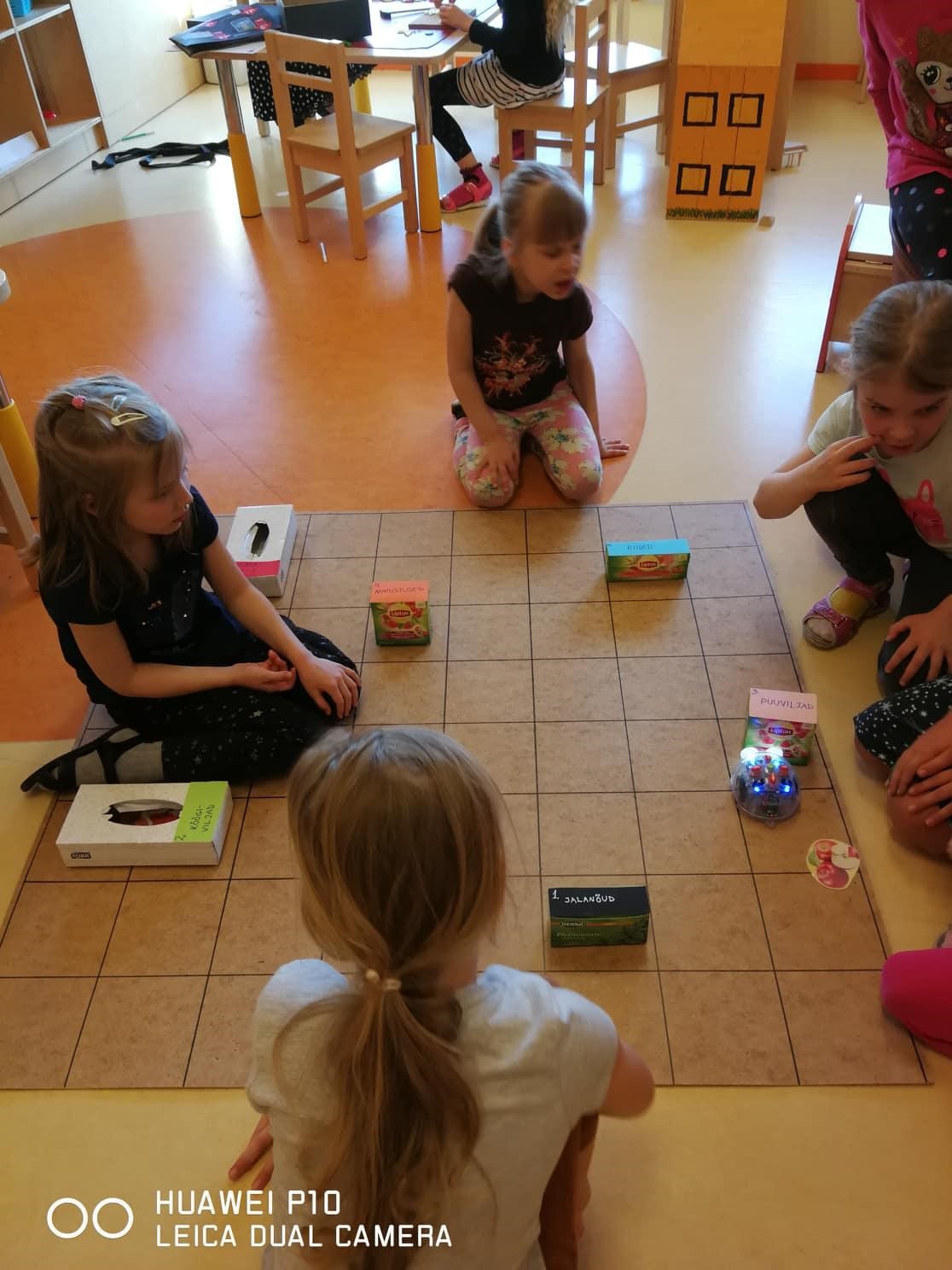
- Group 2 (materials: reused materials)
Creative game “Shop” with reused packages and materials.
This is a traditional creative game of shop with ‘real things’, i.e. actual product packages, used and cleaned, of different types. The children themselves decide who are the shopkeepers and the buyers. The ‘purchased’ products can be packed into used paper bags, payments can be done in claps, previously crafted materials or anything else. Children ages 6-7 will use English language words for as many products as possible, as well as communication.
Finally, the activity ends with the discussion, lead by the teacher.
What went well, what not? What was easy, what not? How did you feel as a shopkeeper and as a buyer? Etc., depending on what the focus of the discussion is. The teacher then thanks the children for discussin how they felt.
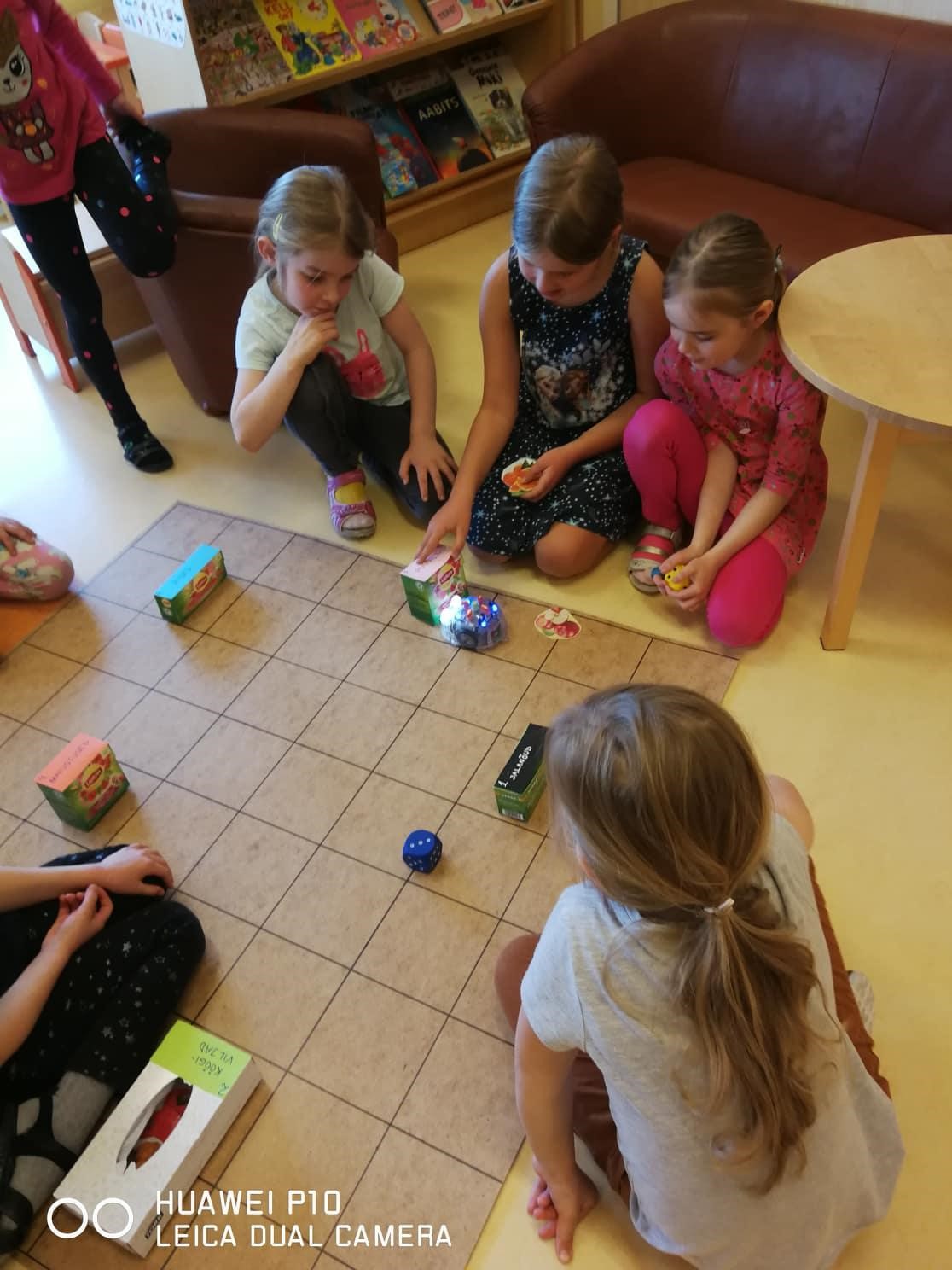
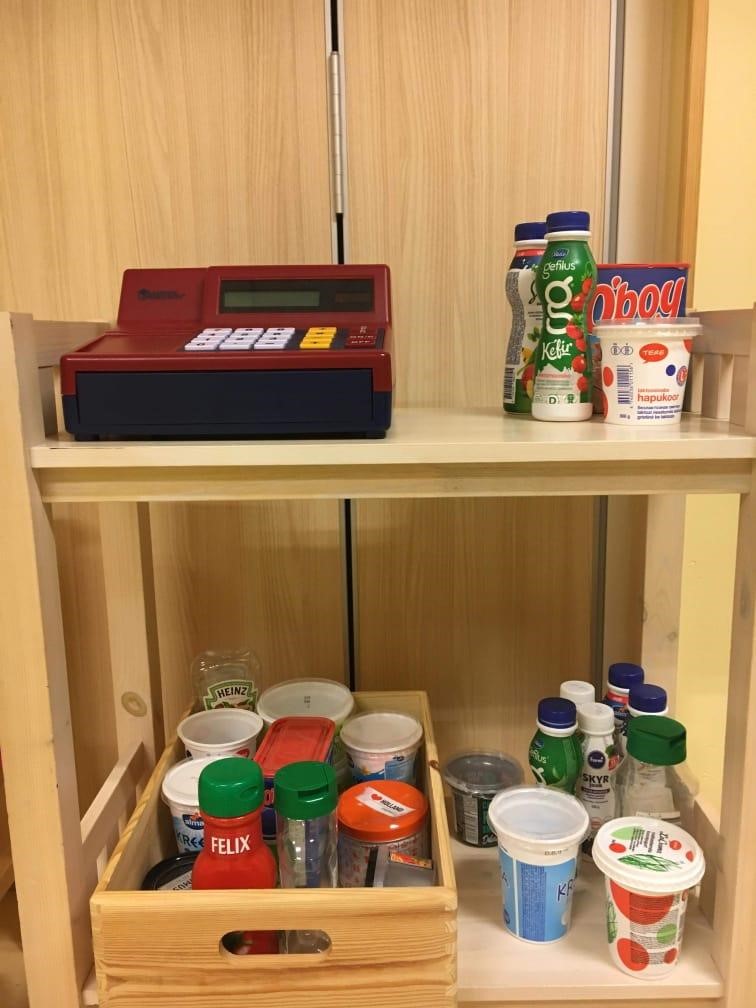
--------------------------------------------------------------------
III COLOURS
Description: First, the children learnt some colour names in English. Then, they used the educational robot Blue-Bot to create a mosaic pattern on a paper, colouring it afterwards based on the colours the teacher said in English.

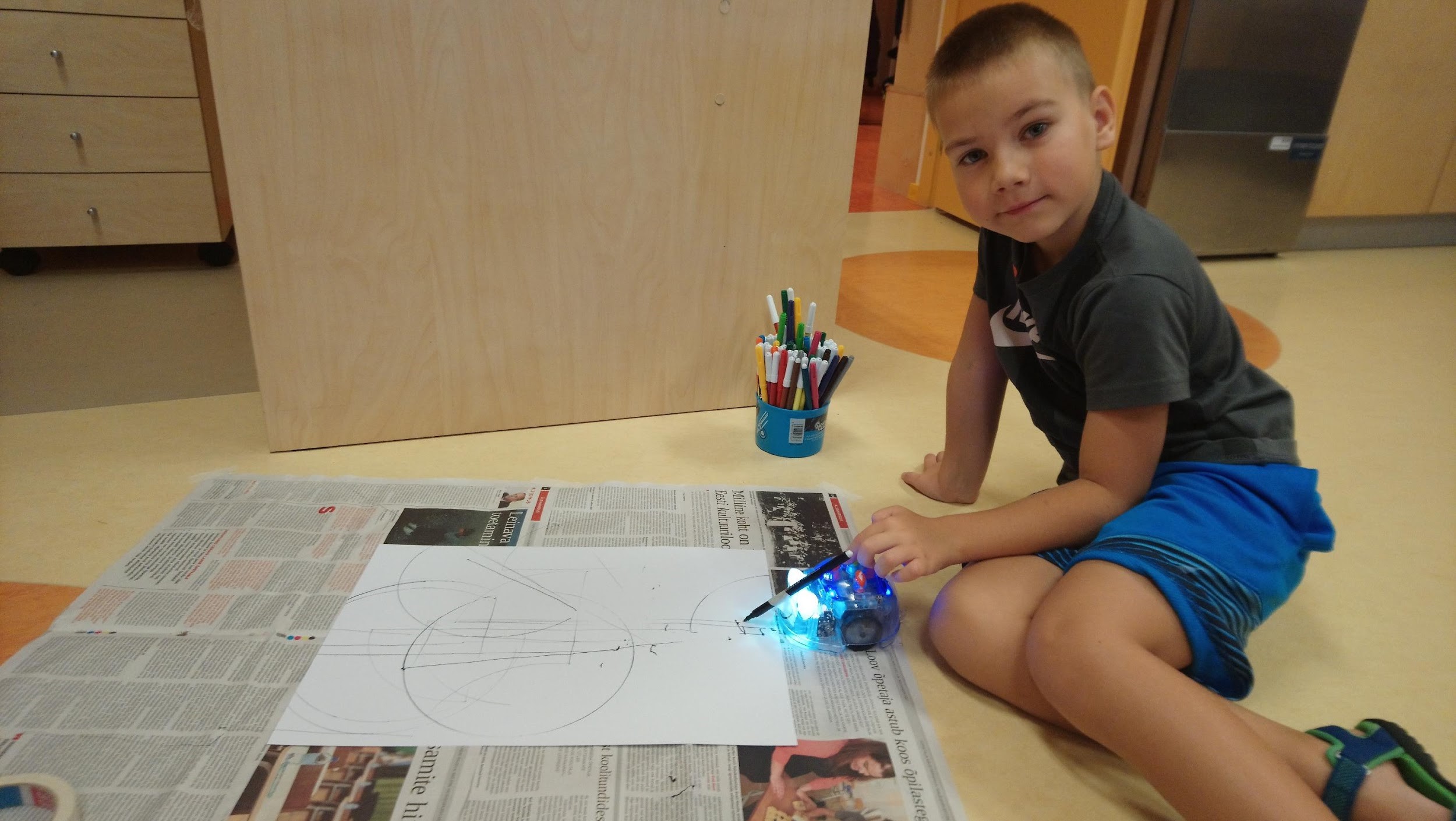
Time: November 27th, 2017
Group: Allikalapsed
Age: 6-7 years
Teacher: Eliko Tippi
Objectives:
The child can use the educational robot Blue-Bot for drawing (with the aid of a pencil attached to the robot) and create their own work of art.
The child can program and lead the Blue-Bot.
The child orientates on paper and knows the phrases ‘right-left’, ‘up-down’, ‘forward-back’.
The child knows some names of colours in English.
Materials: Colour cards, Blue-Bot, paper, marker, watercolours.
Order of activity:
The children sit in a circle and the teacher shows them the colours cards, saying the correct name in English with the children repeating after her. Then, the teacher places the cards on the floor and says a colour name in English, the child who finds the correct card first, wins. Afterwards, the teacher places once again the cards on the floor and says the names of the colours, this time, one by one, every child picks the correct card.
The children attach a marker-pen to the Blue-Bot and program it to move on the paper, creating a personal mosaic pattern. They then paint the pattern based on the colours the teacher names in English.
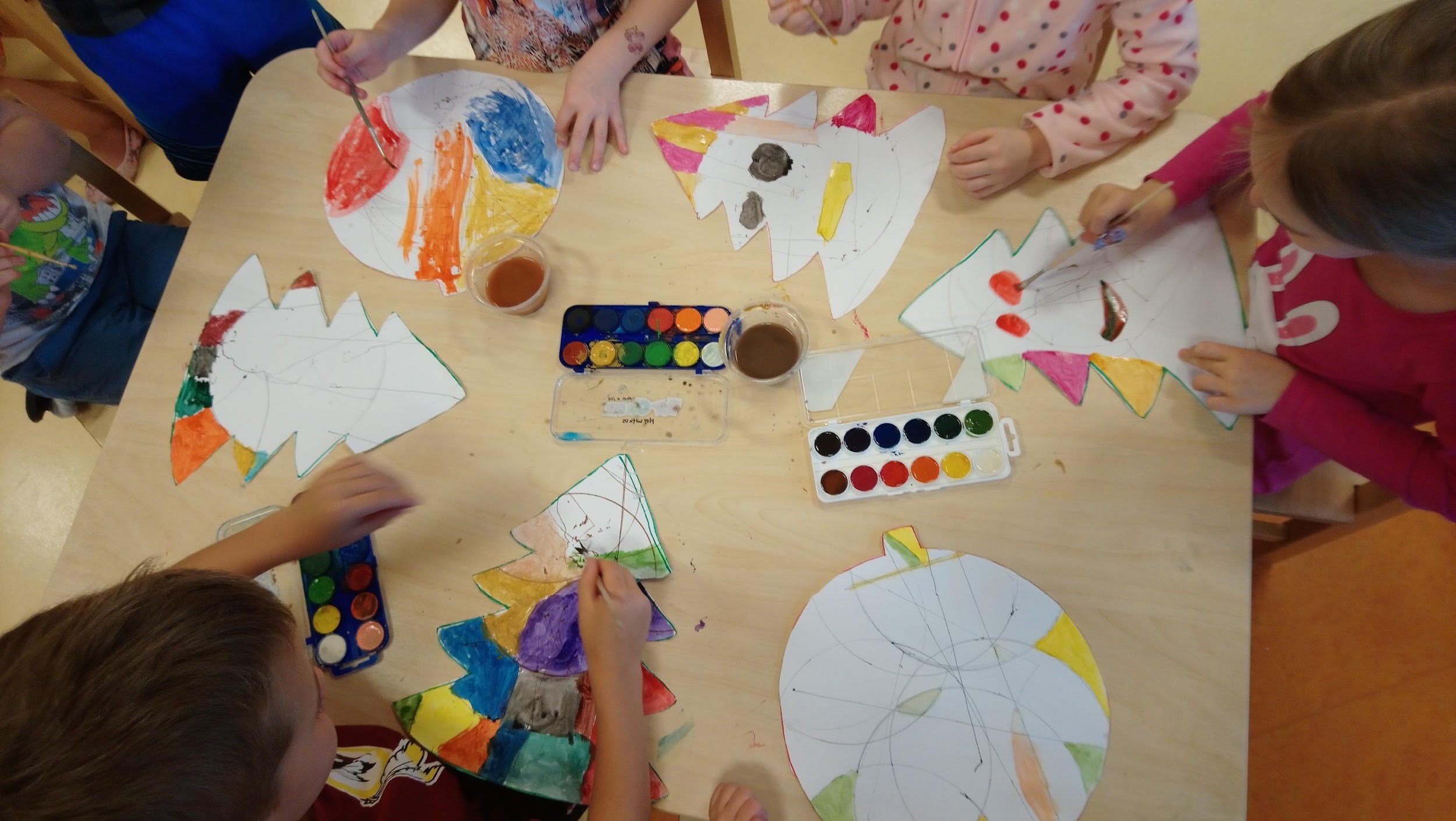
-------------------------------------------------------------------------------------------
IV PERFORMATIVE PLAY WITH SHADOW PANTOMIME
Description: The children create their own shadow puppets and use them creatively in a performative play. They produce the play themselves, using the words and expressions in English that they have studied.

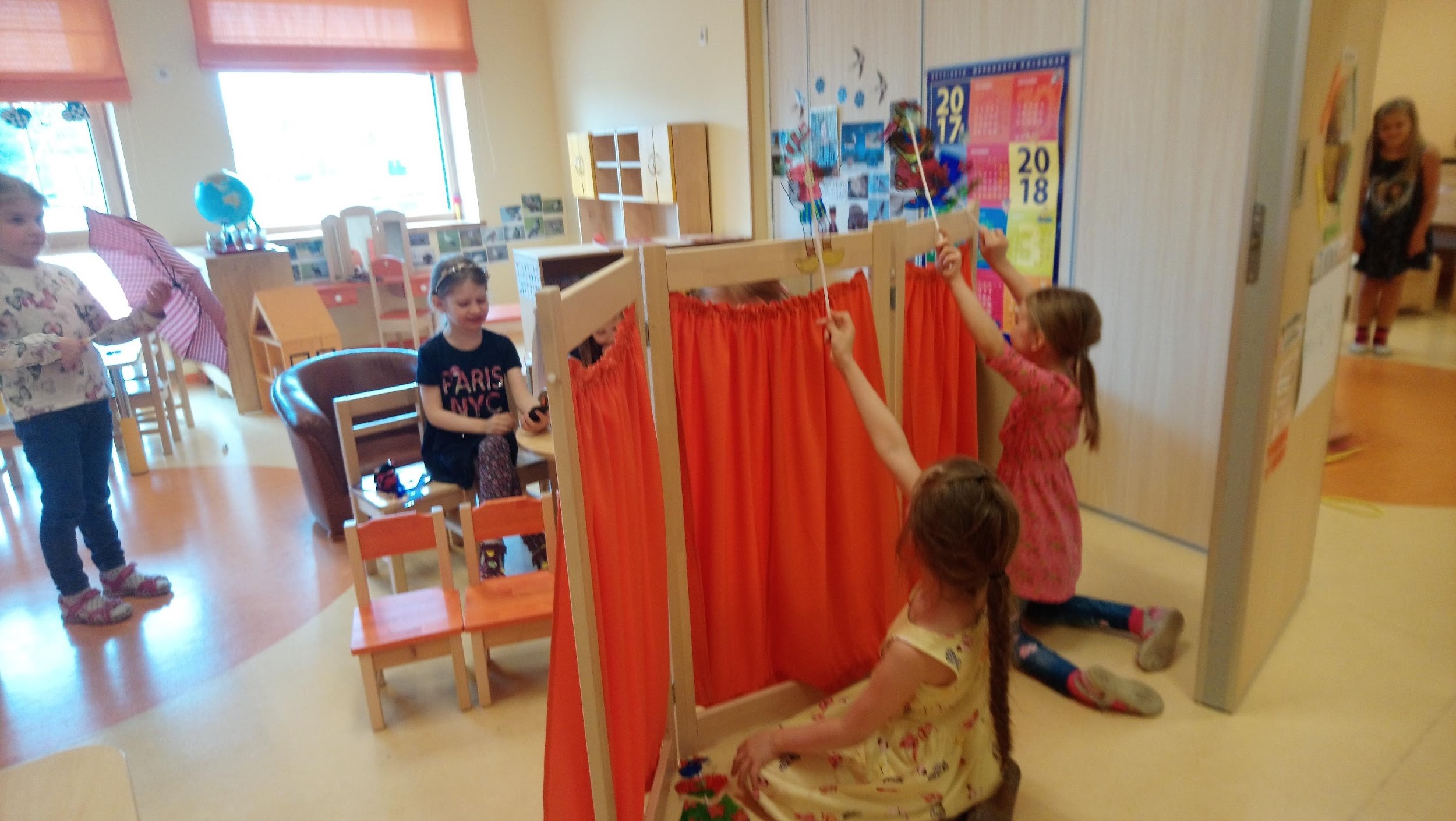
Time of activity: April 17th, 2018
Group: Allikalapsed
Age: 6-7 years
Teacher: Eliko Tippi
Objectives:
The child applies their experiences, knowledge and understanding of the surrounding world creatively in the play.
The child knows how to use appropriate materials creatively while playing and express their ideas during the game.
The child can use newly learnt foreign vocabulary while playing.
The child uses full sentences in their speech.
Materials: shadow puppets created by themselves, a screen
Order of activity:
The children took part in a shadow puppet workshop in the NUKU Theatre (The Estonian Puppet Theatre) and created their own puppets. The children used the puppets for performative plays and creative play. The children used newly learnt English-language phrases and words while performing and playing (expressions for greeting, saying good-bye, thanking, asking, introducing themselves, asking for the other’s name etc.)
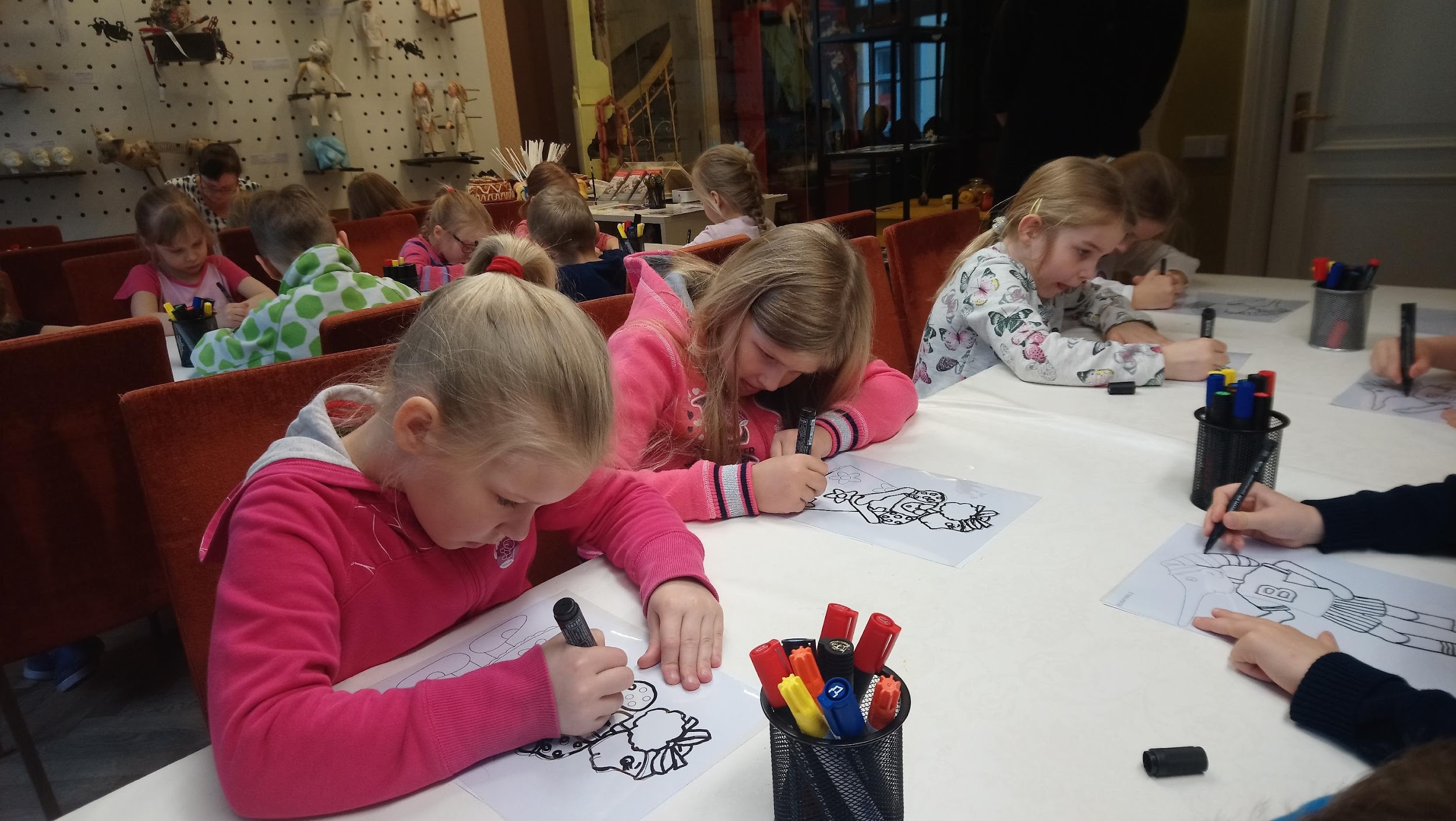
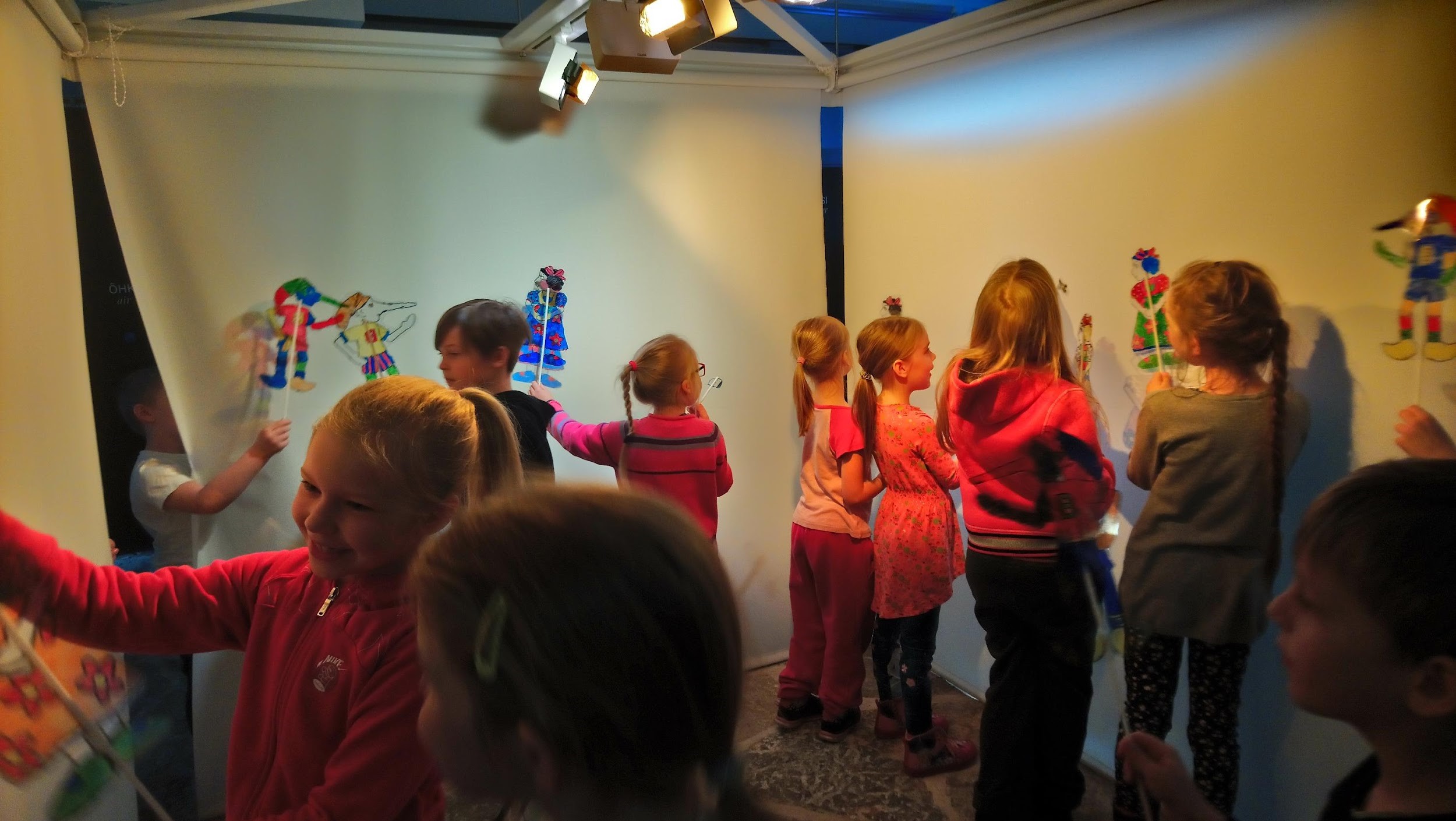
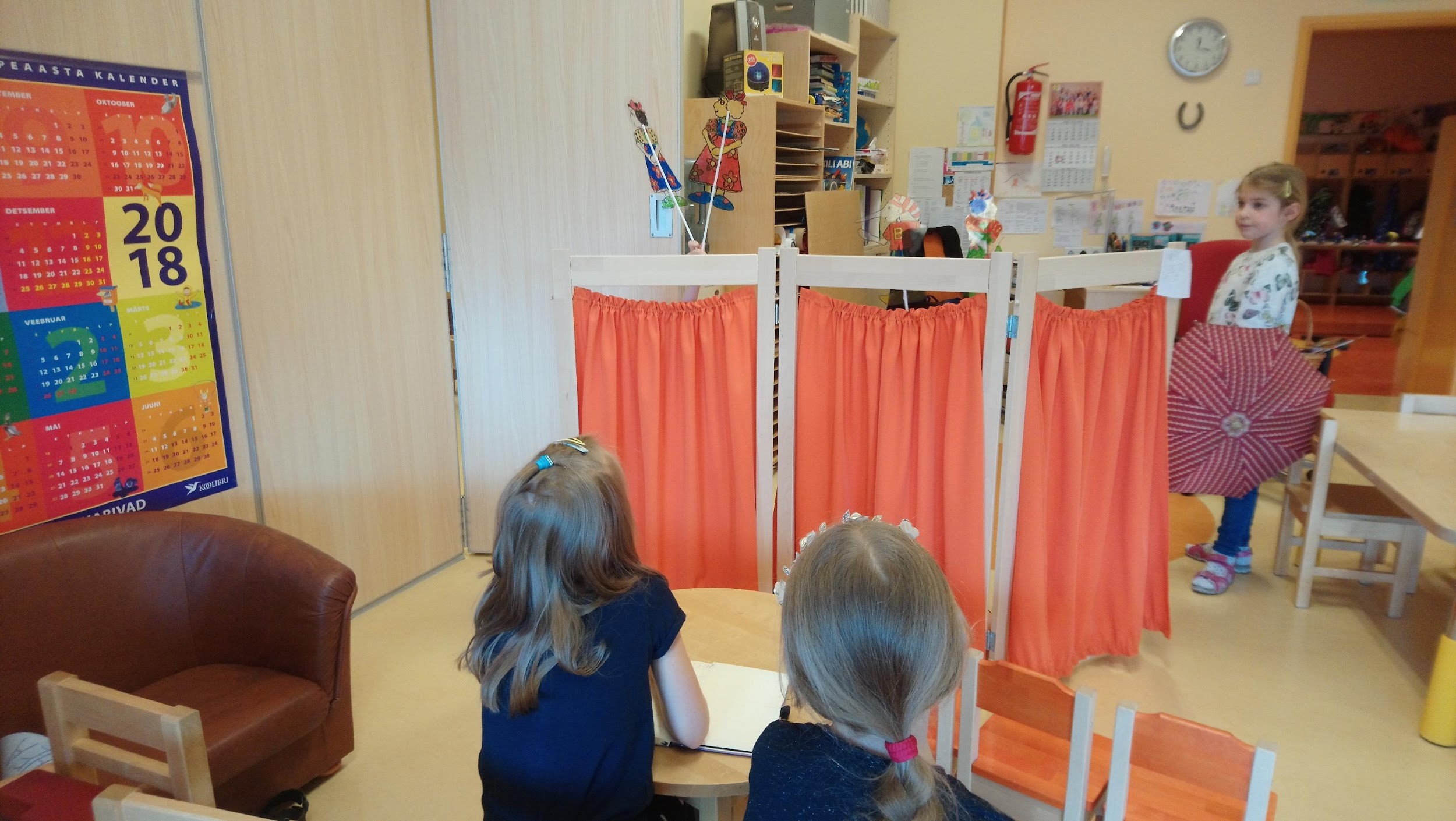
-----------------------------------------------------------------------------------------------
V BOARD GAME “INGLISE KEELE ABC” (“THE ENGLISH LANGUAGE ABC”)
Description: The child finds partners for other picture cards and names the objects on the photos both in Estonian and in English.

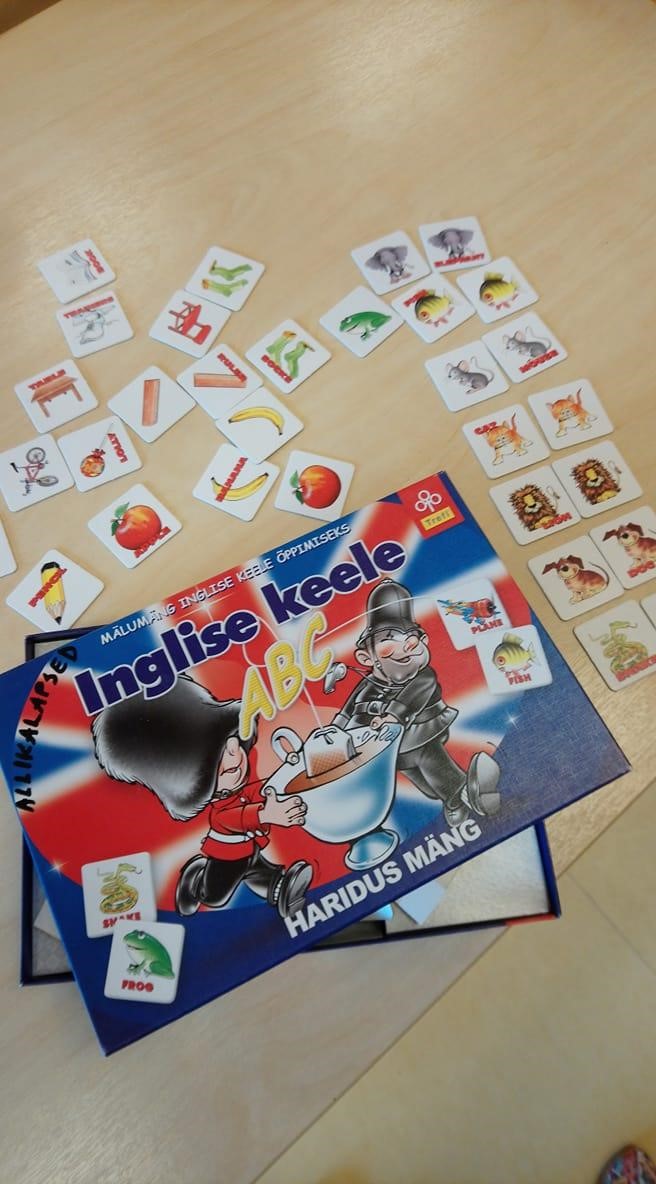
Time of activity: March 1st, 2018
Group: Allikalapsed
Age: 6-7 years
Teacher: Eliko Tippi
Objectives:
The child uses picture cards to learn new vocabulary in English (animals, fruits etc.)
The child applies the Memory-game principles to find a partner for each card.
The child knows the rules for playing, can stick to them and explain them to their companions.
Materials: The board game „Inglise keele ABC“
Order of activity:
The teacher shows a picture card to the kids and names the object both in Estonian and English. The children repeat the words. The teacher lays the cards on the table, face up, and says a word in English. The children find the correct card. Finally, the children lay the cards down, face down, and the game continues as a common Memory-game of finding partner-cards. Upon finding the correct pair, the child names the object on the photo in English. If necessary, the teacher and/or the other children help the player.
---------------------------------------------------------------------------------------------
VI LEARNING A SONG: “THE NUMBER SONG”
Description:
The teacher started by explaining how the numbers are counted in the English language. Then, they listened to the song lyrics to help them remember the numbers further.

Time: October 16th 2017
Group: Allikalapsed
Age: 6-7 years
Teacher: Katrin Mandel
Objectives:
The child can read numbers in English up to 10 (with the help of musical activity)
The child understands the content of the song and can recite it expressively by heart.
Materials: a piano
Order of activity:
First, the children learn to count the number up to 10 in English (since they had had some contact with the numbers in English before, this part was easy). Easily rhyming lyrics and an appropriate tempo of the song also simplified the learning process.
Üks on one ja kaks on two
kolm on three ja neli on four
one, two, three, four
laulan sõpradega koos.
viis on five ja kuus on six,
seitse on seven ja kaheksa eight
five, six, seven, eight
mõnel on püksid ja mõnel on kleit.
üheksa on lihtsalt nine, kümme lihtsalt ten
mõnel on õde ja mõnel on vend
one, two, three, four, five,
six, seven, eight, nine, ten.
kui tuju rõõmsaks lauldud on,
siis tuleb happy end!
(Translation: One is one and two is two
three is three and four is four
one, two, three, four
I am singing with my friends.
Five is five and six is six
seven is seven and eight is eigth
five, six, seven, eight,
one has pants and one has a dress.
Nine is just a nine and ten is just a ten
One has a brother and one has a sister.
One, two, three, four, five
six, seven, eight, nine, ten -
when the song has made us smile
there will be and happy end!)
Sources: Lyrics and melody by Katrin Mandel (the music teacher of Nõlvaku Kindergarten)
---------------------------------------------------------------------------------------
VII LEARNING A SONG: „WE WISH YOU A MERRY CHRISTMAS“
Description:
The children listened to the known Christmas song and it’s refrain, discussed the content and repeated the lyrics.

Time: December 6ht, 2017
Group: Allikalapsed
Age: 6-7 years
Teacher: Katrin Mandel
Objectives:
The child uses music to learn a foreign language.
The child understands the content of a song.
The child enjoys performing the song.
Materials: a computer, internet, a piano
Order of activity:
The children listened to the refrain of the famous Christmas song and the teacher explained the lyrics and their meaning to them. By repeating and singing along the lyrics in English were learned by heart very quickly.
„We wish you a Merry Christmas“
We wish you a Merry Christmas
We wish you a Merry Christmas
We wish you a Merry Christmas
And a happy New Year.
Sources: https://kidsongs.com/lyrics/we-wish-you-a-merry-christmas.html/
-----------------------------------------------------------------------------------------------------
VIII LEARNING A POEM: „I LIKE TO SEE CHRISTMAS“
Description:
The children listened to the known Christmas poem and discussed the content and repeated it until they know it by heart.
Time: December 6ht, 2017
Group: Allikalapsed
Age: 6-7 years
Teacher: Kristi Hansen and Eliko Tippi
Objectives:
The child uses a poemas a way to learn a foreign language.
The child understands the content of a poem in English.
The child enjoys performing the poem.
Order of activity:
The teacher reads the children a poem called „I like to see Christmas“ and discuss the meaning of the different words. The children learn the poem and read it in the Christmas time to Santa Clause as a joint effort.
I like to see the stockings
I like to see the gifts
I like to see the bells
I like to see the tree
And I like to see Santa
Looking at me
Sources: https://www.loveliveson.com/christmas-poems-for-kids/
----------------------------------------------------------------------------------------------------------------
IV LEARNING A DANCE TO A ENGLISH LANGUAGE SONG
Description:
The children listened to the known Christmas songs and discussed the content and repeated it until they know it. Later on they learn a dance to the song, wich they perform during the Christmas concert.
Time: December 6ht, 2017
Group: Allikalapsed
Age: 6-7 years
Teacher: Kristi Hansen
Objectives:
The child uses a song as a way to learn a foreign language.
The child understands the content of a song in English.
The child enjoys performing a dance to a English language song.
Order of activity:
The teacher reads the children the lyrics of commonly knows songs „Jinglebell Rock“ and „Let it snow“. Together they learn the meaning of the different words. The children learn the songs and dances that help to remember also the meaning of the lyrics. Children perform their dances during Christmas time to Santa Clause as a joint effort.
Glee Cast: Jingle Bell Rock
Jingle bell, jingle bell, jingle bell rock
Jingle bells swing and jingle bells ring
Snowing and blowing up bushels of fun
Now the jingle hop has begun
Jingle bell, jingle bell, jingle bell rock
Jingle bells chime in jingle bell time
Dancing and prancing in Jingle Bell Square
In the frosty air
What a bright time, it's the right time
To rock the night away
Jingle bell time is a swell time
To go gliding in a one-horse sleigh
Giddy-up jingle horse, pick up your feet
Jingle around the clock
Mix and a-mingle in the jingling feet
That's the jingle bell rock
Jingle bell, jingle bell, jingle bell rock
Jingle bells chime in jingle bell time
Dancing and prancing in Jingle Bell Square
In the frosty air
Dean Martin: Let it Snow
Oh the weather outside is frightful
But the fire is so delightful
And since we've no place to go
Let It Snow! Let It Snow! Let It Snow!
It doesn't show signs of stopping
And I've bought some corn for popping
The lights are turned way down low
Let It Snow! Let It Snow! Let It Snow!
When we finally kiss good night
How I'll hate going out in the storm!
But if you'll really hold me tight
All the way home I'll be warm
The fire is slowly dying
And, my dear, we're still goodbying
But as long as you love me so
Let It Snow! Let It Snow! Let It Snow!